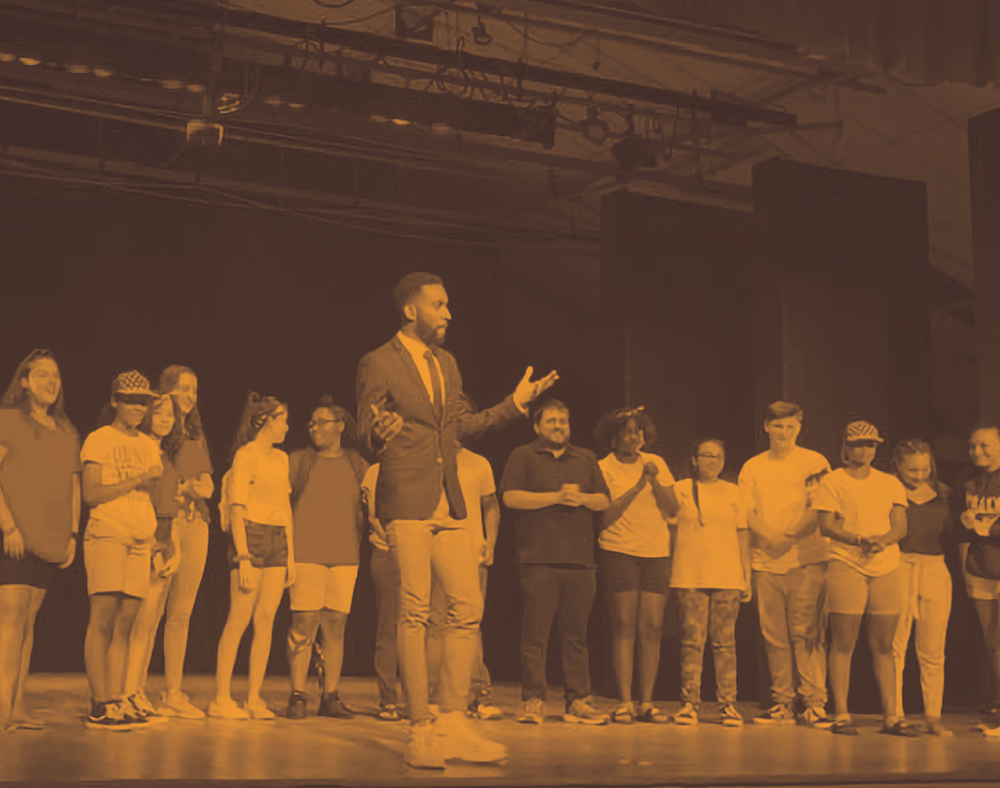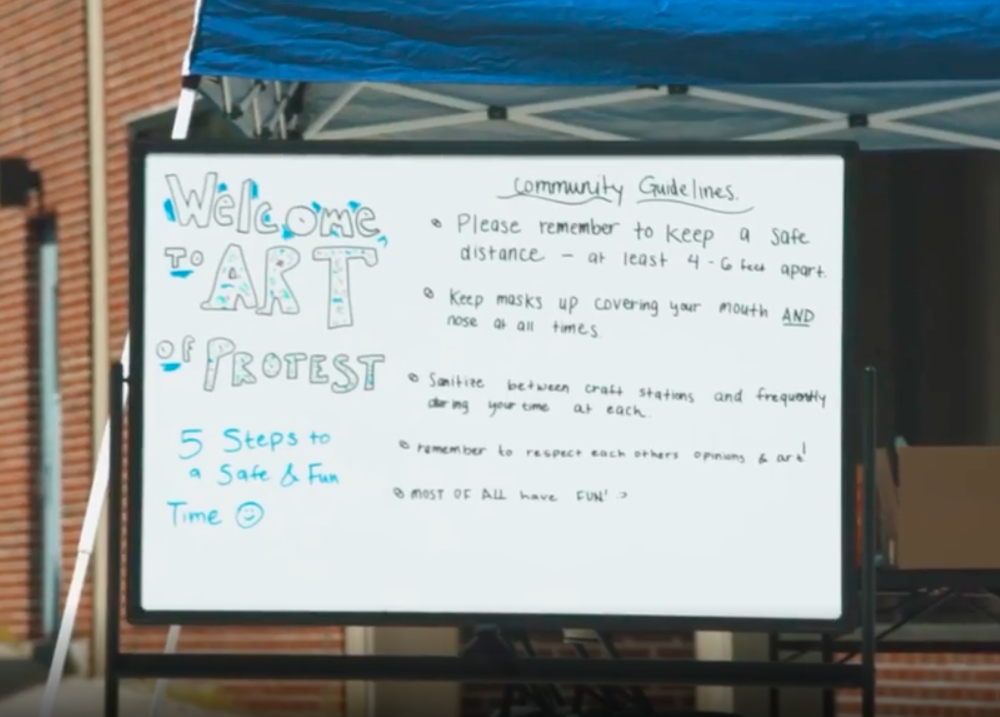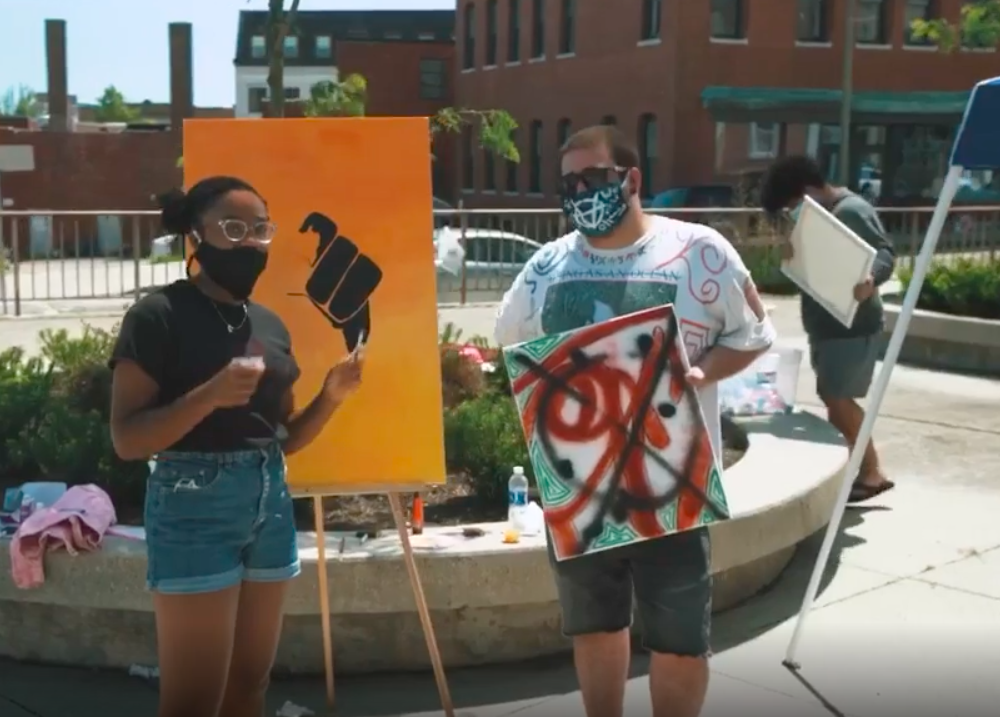Igniting Social Change Through a Screen
Writer’s Block inK was started in 2003 in New London, Connecticut, as a non-profit organization to support youth in writing and performing as tools to address personal and social challenges on the community stage.

Kolton Harris greets the audience at last year’s opening night of [Un] Documented, a performance created by students to address and challenge the state of immigration in the U.S. Photos courtesy of Writer’s Block inK.
By Kolton Harris, Vice President of the Board, Writer’s Block inK
At Writer’s Block, we seek to ignite social change through the arts, letting young people lead and create. At the core, Writer’s Block is about sculpting and creating full-scale productions in theater, including hip-hop musicals, and we have continued to evolve to provide space for various art forms. Writer’s Block inK empowers young voices with the power of pen and prose, reinforcing teamwork, accountability, and responsibility; igniting social change on the page and stage. My relationship to Writer’s Block is a testament to the youth-led model—I attended Writer’s Block inK as a kid, volunteered, worked as Executive Director, and currently serve on the Board to advise on strategic vision and to build capacity to sustain our work.
The Writer’s Block team has worked, like many others, to transition our programming from in-person, communal activities to a rewarding virtual environment, and the success that we have achieved has been largely thanks to the commitment, creativity, and leadership of our students, who embraced this world of online creation, while continuing to share their artistry and ideas in a time when recent social and political upheaval highlights the importance of them sharing their voices with our local community and the world.
When sharing narrative and decision making power, all of us at Writer’s Block benefit. Maintaining that shared power through a global pandemic has offered the organization a chance to try new approaches and take risks. I’m excited to share our organization’s story, in the hopes that our longstanding model can provide lessons learned for challenging the ways things can be, as a team
Leading Writer’s Block Through a Pandemic
Prior to COVID, Writer’s Block inK was in the process of redesigning our programming and introducing new approaches to our education model. Then the pandemic hit, and it presented an opportunity to alleviate some potential pushback from proponents of sticking to the status quo. We’ve experimented with our model, meeting the needs of our staff and students in improved ways. Normally, in the summer Writer’s Block holds an eight-week intensive, in which young people ages 13 and up come to us every day and create a show from scratch. We have nothing at the beginning of the summer, and at the end, we have a three-night run of the show: no scripts, fully lit, costumed, and staged. Our last production, [Un]Documented, explored the harsh realities of immigration in America. This process has always been driven by the students.
This year, we collectively redesigned the program into the Block Academy for Art and Social Change. Instead of sculpting a show, we split up the students into virtual cohorts based on their artistic interests, including visual art and design, music and song writing, dance, acting, poetry, creative writing, and research and education. The students can participate in as many cohorts as they want, and we have some students who are in every group.
This transition to a whole new program has been relatively easy to get off the ground, and it’s because of the students who are participating in the program. By involving the people who are supposed to benefit from our work the most, young people, this platform allows them to share their dynamic, creative work.
In their respective cohorts, students work with our staff to discover themselves and their craft, and they also participate in a series of group projects. Instead of one big show at the end of the summer, we transformed our physical space into a gallery in which our visual artists can display their work. We will have a physically-distanced opening, where people can bid on the work, and the young people receive a significant cut of the proceeds—they can make money from their art.
By involving the people who are supposed to benefit from our work the most, young people, this platform allows them to share their dynamic, creative work.
Every summer, Writer’s Block gives a word that the students focus on for the duration of the program, and this year that word is liberation. Everyone is creating art around liberation and acknowledging specifically racial upheaval.
I am really excited about this disruption, because normally when we produce our three night show, it does get filmed, but not a lot of people see it or have the ability to come and sit through a two-hour show. With a zine on the other hand, which some of the students are creating, it can sit on someone’s coffee table and they can engage with it any time. People in the area can come to our gallery and see the art at their leisure, but someone across the country can also go on YouTube and check out a powerful monologue from a young person about the issues that matter to them. It is allowing the work of our artists to reach more people.
Navigating a Virtual Arts Education Program
For young people, especially when they get to be a bit older, it is hard to commit to being in one place for five hours a day, four days a week, especially when many of them have the added responsibility of needing to work a summer job or take care of siblings to help their families. Having the flexibility of being able to log on to a two-hour cohort on Zoom works for their lives, and they also like the freedom that they have to dig a little deeper into what we have been working on in their own time.
In building the schedule for our virtual programming, we addressed these challenges while maintaining our approach of having the young people be at the forefront of the creative process. We asked them what would work best, and then that’s what we did. While involving students in decision making this thoroughly is not something conventionally done, we have always maintained the importance of open lines of communication, and this has helped us to stay productive and positive.
Challenges include students not having access to the best Wifi or resources to tune in virtually, and of course the loss of connection that comes with not being able to meet in person, but overall the discussions that we have had over Zoom have been some of the most engaging sessions that we have ever had. And this is completely because of the young people participating in the program this year, and their commitment, passion, and creativity.
Even in our research and education course, the only mandatory virtual class this summer, we have made it a point to ensure that the space doesn’t feel like their school experience. Instead we open it up for dialogue and ask the group about concepts and words that they have heard that they don’t know, for example, and then we look them up together and create a resource list for each other. There is no pressure of a curriculum, just the objective of community sharing with what we learn and discover. We’re focused on providing an environment for personal growth.
We also do not cater to “artsy” kids exclusively. One of our students is set on being a forensic scientist, but she keeps coming back to Writer’s Block because of the tools and resources that we provide for her to help her become a better critical thinker. At a young age, she has the opportunity to analyze documents and synthesize data to formulate her own ideas, because we don’t hold information back from these young people, and we allow research to be very exploratory and intense.
COVID-19, in prompting us to move our programming online, has allowed us to reach more young people from different locations than before; we even have one student participating from California. The goal is to continue this program in some capacity in the fall, because we have received feedback from students who live farther away from where we are located that they would like to continue working this way.
Writer’s Block will continue to provide online, workshop-based programming in poetry and creative writing, and in the future we will work toward a hybridized model of in-person 32 and online content, so that we can rekindle the intimate sense of community that comes with face-to-face interaction, while also capitalizing on the benefits of online programming. We’d also love to continue to evolve our programming into different genres, film is one area for example.

This summer’s The Art of Protest event invited the Writer’s Block community to celebrate art as an integral part of protesting. The social distance gathering created a community mural, upcycled clothing, and signs.

Creating Socially Driven Art during a Time of Social Upheaval
I believe that even in a small way, Writer’s Block inK is a leader in the work of catalyzing a dialogue about social challenges that we face in the world today. It is central to our work and always has been. What has changed lately is that some audiences are now more receptive to what we have to say.
Writer’s Block has always been forward in conveying our messages. It is not uncommon for someone to come see a show and leave before it is done, because they don’t agree with what we’re saying, it makes them uncomfortable, or they thought they were coming to see a little kid’s show, but instead experience a mature, intellectual performance addressing polarizing topics.
What has been a little more difficult is Writer’s Block working through the fact that we have been in the trenches and doing social justice work that has previously been discredited or pushed to the side. Now, because it is popular to talk about, people are more receptive, but there is also a lot of disingenuous allyship that can become challenging to navigate. Because of this, our lane becomes oversaturated. Even though I feel like we are doing authentic work, and uplifting authentic voices and experiences, it can feel like our work is being drowned out by those who are making their voices heard, but who have superficial intentions at the heart of their statements.
A lot of our students have expressed this too: they are not fond of the performative social justice work that’s not grounded in the reality of the work. For many of the students who come to Writer’s Block for years, they are leaders and voices in their schools, communities, and households, and this is not always an easy path for them to take. These young people have been involved in the discussion and the fight for social justice long before it became fashionable, so for them it can be frustrating to have been in a fight that had largely been dismissed, and then to all of the sudden see so much support, which is not in all cases sincere. For the progress made in our work, where youth voices are amplified, this is a challenging blow.
As the world around us continues to evolve, Writer’s Block has been and will continue to stay true to our mission, which is to empower young people to voice their viewpoints and to stay educated—to research and learn about what is going on in the world, and to give them the means to share their thoughts and ideas through their artistic expression. Writer’s Block inK will continue to take our evolution in stride, to turn hurdles into opportunities for continued growth and success for the organization, and, most importantly, for the young people who we have the privilege of working with and learning from.

